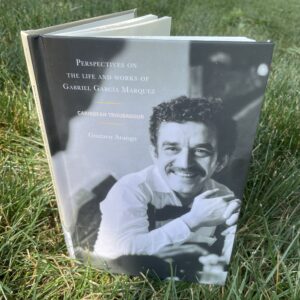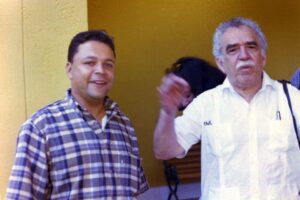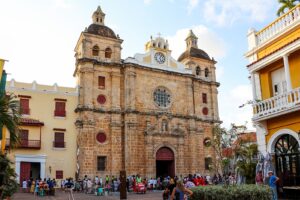
Click on image to find the book on the publisher’s website
Have you ever read a book that had such a profound impact that it defined you and your career for the rest of your life? Contributing to the English-language literature on Colombian Nobel laureate García Márquez, Perspectives on the Life and Works of Gabriel García Márquez, written by Rutgers alum Gustavo Arango is an inspiring story at the crossroads of literary criticism. It is both a biography of García Márquez with new elements, and Arango’s memoir.
Touched by Leaf Storm, the first novel published by García Márquez, the young Arango has chosen a career path early in his life that intertwines reading, researching, interpreting, teaching, and writing about the works of one of the greatest authors of our time, thanks to the librarian in his high school library who made Márquez’s books available for their young students.
The first steps

Click on image to find the book on Amazon
Following in the footsteps of García Márquez, who also wanted to become a writer early on, Arango decided to study journalism to learn the trade. After graduation, he accepted a position as a journalist at El Universal in Cartagena de Indias because he read that García Márquez greatly attributes his writing skills to his initial experience working there as a news reporter in 1948-49. After all, isn’t a writer merely a journalist who has learned to write better than the others?
Researching articles written by his role model for El Universal, Arango discovered texts by García Márquez published without signing his name or initials. He collected and shared them, along with testimonies by García Márquez and his friends in a book published in 1995 entitled A Bouquet of “forget-me-nots” (in Spanish as Un ramo de Nomeolvides). It was so appreciated by García Márquez himself - to the point that, when he borrowed a copy from his friend, he told him to “consider it to be stolen.”
Meeting your role model

Gustavo Arango with Gabriel Gárcia Márquez in Barranquilla in December 1997 (From Gustavo Arango’s Facebook page)
Perspectives on the Life and Works of Gabriel García Márquez is peppered with inspirational stories of the two writers’ personal and intellectual encounters. The moments of the most intimate connection between the great writer and the apprentice, which took place during a workshop on narrative journalism in Barranquilla, Colombia, in December 1997, are unveiled in the chapter entitled “Lessons of the Master.” With advice withstanding time, this early version of today’s online master classes introduces aspiring writers to the nitty-gritty of quality writing through the lens of Arango, the journalist and creative writer, learning from the master himself. Spoiler alert: The tools and tricks of the trade remain the same, with good editing taking the podium time and time again.
With a name identical to a famous fashion designer (a heads-up, just in case you Google the name), Arango has achieved it all and more. He has become an accomplished author with outstanding feedback from readers, publishing several successful books, mainly in Spanish. He has also become an official “Gabologist” (Gabo is García Márquez’s nickname), who made a real difference with his scholarship rather than just growing the mandatory reading list of peer-reviewed articles for his college students.
Scholarly and popular
As for scholarly content, Perspectives on the Life and Works of Gabriel García Márquez intends to offer a “better understanding of the origins, creative practices, and prevailing themes” in the Nobel laureate’s works. In Arango’s own words, the book reflects his multiple perspectives on the life and works of Gabriel García Márquez as a regular reader, an aspiring writer, a journalist, a biographer, and even as his teacher. It is a pretty unique perspective, resulting in an entertaining read (even for rigorous academic audiences), masterfully written by a creative mind in a style matching a more personal approach.
For researchers, also notable is Part II, “The Troubadour Files.” With its valuable primary source material, this section backs up the last chapter of Part I, in which Arango calls García Márquez the ”Caribbean Troubadour.”
Adding to the English-language literature
Chapters of this book are often based on Arango’s publications and presentations, which are available only in Spanish. Thus, this book adds to the knowledge of the English-speaking world about one of the most influential Latin American writers of the 20th century.
One of Arango’s most significant contributions to world literature is revealed in chapter 10, through an English-language version of his article entitled “A defense of a posthumous novel,” originally published as “La soledad de las palabras” in Spanish in Confabulario, the literary magazine of the newspaper El Universal (Mexico City). Based on his research on the manuscripts located at the Harry Ransom Center of the University of Texas in Austin, Arango argues that, even if García Márquez had decided against publishing the unfinished novel, only minimal edits would be necessary to finalize and publish this novel, and it would significantly contribute to the author’s oeuvre.
Apparently, his justification went far enough. The novel En Agosto Nos Vemos was published earlier this year in multiple languages (Until August in English).
In this Spanish-language video Gustavo Arango talks about rescuing the unpublished novel En Agosto Nos Vemos on NTN24, a Colombian cable TV news channel, in March 2024.
Cartagena de Indias, a love story
As a librarian, I find the detailed chronology of Gabriel García Márquez’s life equally valuable, including the most relevant works with the original Spanish title and year of publication. However, my favorite part is Chapter 6, “García Márquez and Cartagena de Indias, a love story.” Cartagena has a special place in the life and works of García Márquez, a place that he revisits multiple times, both literally and figuratively. The details of the city’s history provide the background to many of his novels, as Cartagena shows up several times, such as in my personal favorite Love in the time of cholera and Chronicle of a death foretold. Want more? Watch the movies filmed on location there, and you may decide to add Cartagena to your bucket list too.

Iglesia de San Pedro Claver, Cartagena, Colombia. Image credit: Bernard Gagnon
Cartagena was where García Márquez’s writing career began in 1948. The book covers this period from his initial experience of spending his first night in the city in April 1948 (unaware of the curfew), to becoming a local celebrity in July 1949 by giving a speech at the coronation of a beauty pageant. Among the fascinating tidbits about García Márquez’s career as a rookie journalist, the most interesting for any budding author would be the relationship that he built with editor Clemente Manuel Zabala, who held not only the hand of the future Noble laureate at the beginning of his career as a journalist but also his pen, editing his very first news articles with quite a heavy hand.
Inspiration from Colombian writers
Based on portraying writers in his books, there is a lot to learn from García Márquez about writing, but that’s another post for a more qualified expert. You may want to start reading books written by authors who listened to him.
Arango, who calls himself an exile from Medellín, one of the world’s most dangerous cities in the last century, became a successful writer and found his new home at SUNY Oneonta after earning his PhD in Latin American Studies at Rutgers. He admits: “My life has been what it has been because after reading Leaf Storm, I didn’t stop reading his other books, nor did I stop following with interest the events of his life.”
We hope that this book will inspire many readers and aspiring authors.
From Rutgers University Libraries
- Arango, G. (2023). Perspectives on the Life and Works of Gabriel García Márquez : Caribbean Troubadour. Lexington Books, An imprint of The Rowman & Littlefield Publishing Group, Inc. – ebook from ProQuest Ebook Central, perfect for reading and browsing.

My favorite García Márquez-quote also made it to the book!